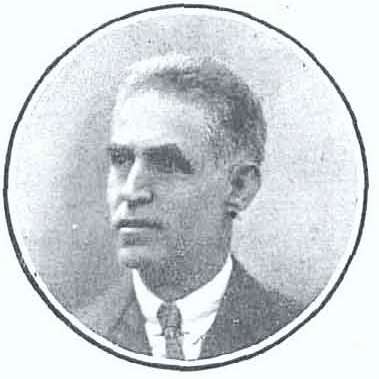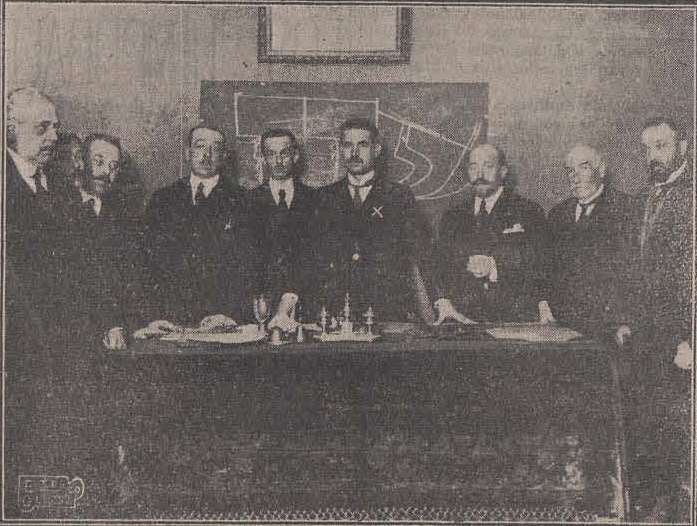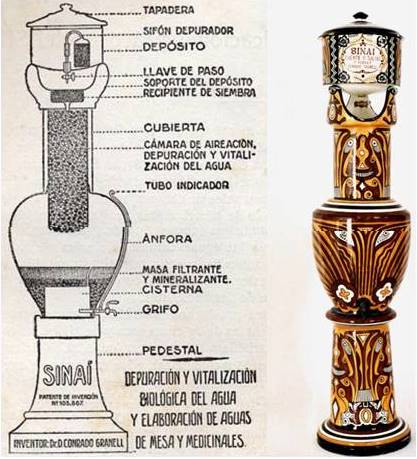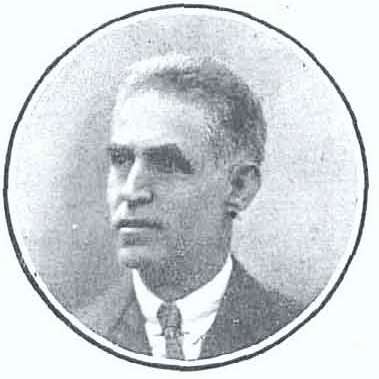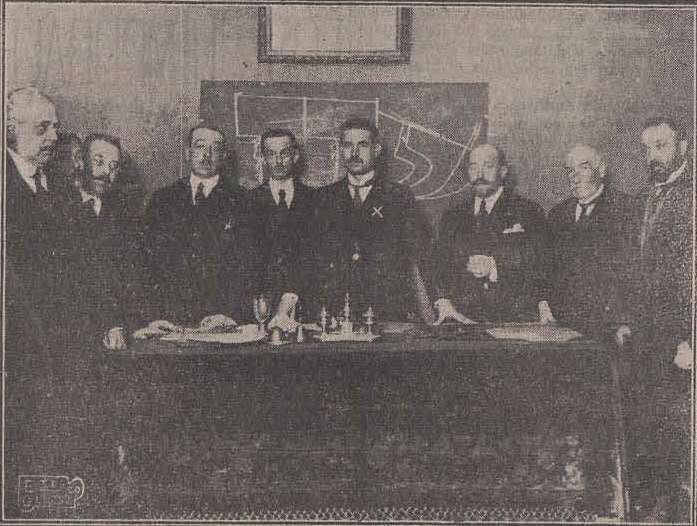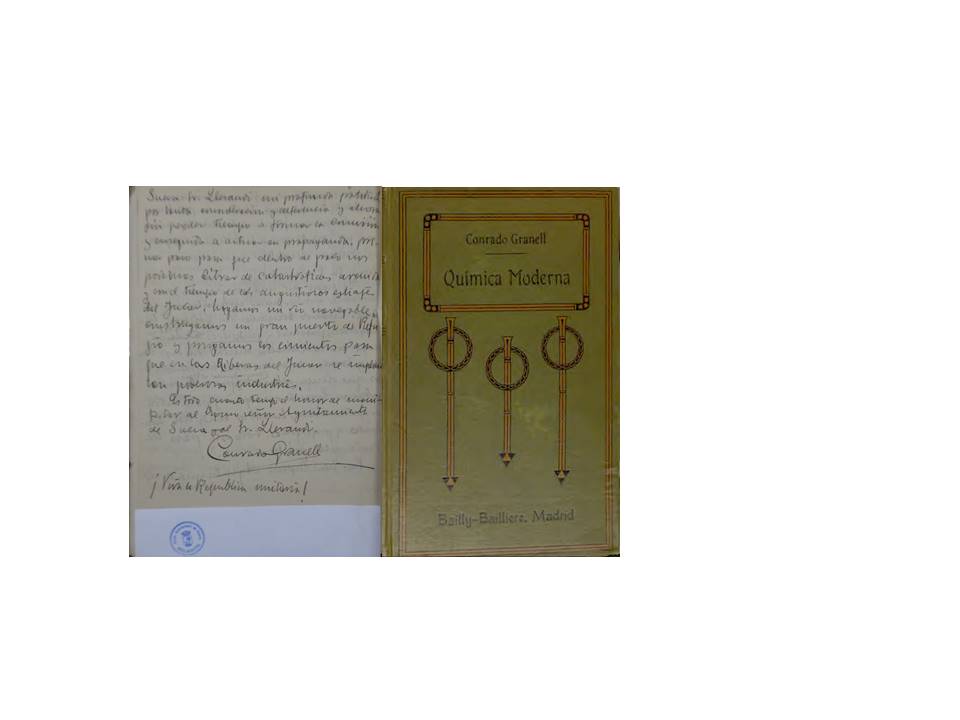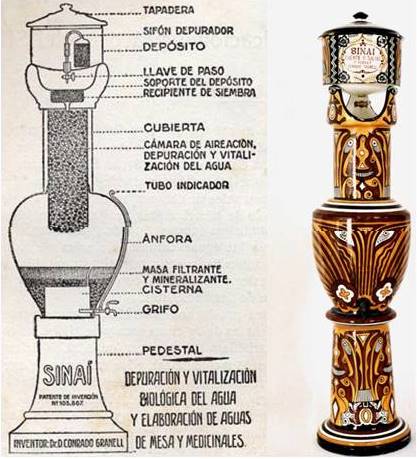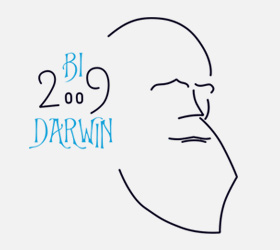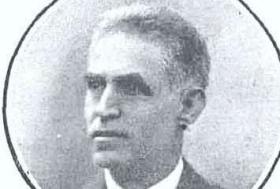
Conrado Granell Modesto
Conrado Granell Street is next to the remains of the Carlist wall of Sueca and the reconstructed machinery of the old Molí de la Baldovina – a relevant example of the Valencian hydraulic heritage –. In 1965, the city council of Sueca dedicated this road to Granell as a remembrance of his “patriotism” and “love for his land of Sueca”. Although Sueca pro-Franco authorities approved such name, Conrado Granell’s relationship with the political and academic elites was not simple throughout his life.
Conrado Granell Modesto (fig. 01) was born in 1877 in Sueca, where his father, Joan Baptista Granell Lledó (1848-1919), was a school teacher and, later, the official chronicler of the city. Conrado obtained the baccalaureate in Valencia in 1895 and enrolled in the University of Valencia to study science. However, he studied the last academic year in Madrid, where he earned a degree in Chemical Sciences in 1901. Shortly afterwards, he returned to Sueca to work as a science teacher at the secondary school where he studied when he was young. Perhaps the lack of a public high school in Sueca where he had the possibility to develop a teaching career and to be able to work as a professor made him go back to Madrid to continue his studies. At that time, and until 1953, the University of Madrid was the only public institution authorised to award a doctorate degree. Then, he prepared a thesis entitled Considerations about the theory of ions in which he proposed a critical review of this chemical theory. Although he began by stating that his purpose was not to “attack or fight” this theory, he concluded his thesis asking himself if it was possible to continue “fully admitting” ion theory after the observations, exhibitions, and interpretations that he had developed. However, Granell could not present this work, resigned to defend it before an evaluation court to deem it “inadequate” and asked the dean the possibility of substituting it for another work. Certainly, the withdrawal or cancellation of a doctoral thesis was not a very frequent question, perhaps Granell was not sufficiently convinced of the quality of his work, but he is also likely to decide not to take a risk with such a controversial proposal. Finally, he obtained a doctorate in chemistry in December 1907 thanks to the thesis Wolframio minerals in Spain, where he did a more traditional review of the main deposits, extraction procedures, industrial uses and applications of this substance. The examining board of this new doctoral thesis was presided over by José Muñoz del Castillo, professor of inorganic chemistry at the Central University and specialist in practical work, and especially water analysis, a question that a few years later became the main field of Granell’s work.
Fig. 01 Portrait of Conrado Granell.
In his university years he wrote some books and articles such as La potasa es un veneno para las plantas (‘Potash is a venom for plants’) (Madrid, 1900), Carbonic mineral waters (Valencia, 1899), and a reduced version of his doctoral thesis entitled Study on tungsten minerals in Spain, which was published in the Bulletin of the Spanish Society of Natural History in 1909. In addition, Granell wrote the Tratado elemental de Química moderna (‘Elementary treatise on modern Chemistry’) (Madrid, 1906). This work was published by the prestigious Bailly-Bailliere publishing house and was reissued in 1913 and 1915 (fig. 03). It was a textbook of general chemistry prepared to be used in universities, normal schools and other educational centres, and also included a good collection of questionnaires and exercises to promote their pedagogical utility. Granell also participated in several scientific congresses, such as the I National Congress of Engineering, held in Madrid in 1919, where he presented a work entitled “Proyecto para un sanatorio de viejos en la Sierra de Gredos” (‘Project for an old sanatorium in the Sierra de Gredos’), or those organised by the renewing Spanish Association for the Progress of Sciences – in Valladolid (1915) and Bilbao (1919) – in which he presented the works titled “Un nuevo gasógeno” (‘A new gas generator’), as well as “Los abonos nitralitas” (‘Nitralites fertilizers’) and “El fósforo en la vida orgánica” (‘Phosphorus in organic life’), published later.
His publications and interventions in different congresses show the evolution of Granell’s interests, which initially were closely linked to the most official academic fields, such as textbooks by publishing houses devoted to teaching or the presentation of works aimed at predominantly university collectives. Progressively Granell combined his participation in these areas related to the academic world with the intervention in other more open areas, such as farmers and workers, whom he taught a course of chemistry applied to metallurgical industries organised by the Working Society of Jewellers in the summer of 1915. Other examples of Granell’s interest in addressing more varied audiences were his conferences and talks that in spaces such as the Association of Agriculturalists of Madrid (1917), the Madrid Athenaeum (1922), the Mercantile Circle of Almeria (1924), the Castellon Literary Athenaeum (1932), the Sueca Athenaeum (1932), the Levante House of Madrid (1933), the Sueca Commercial Athenaeum (1934), the Xativa Popular Athenaeum (1934) and the Castellon Agricultural Chamber (1934) (fig. 02).
Fig. 02 Conrado Granell giving a lecture at the Madrid Farmers Association (1917).
Granell’s interest in connecting with more diverse audiences was surely the result of the difficulties he encountered in consolidating his scientific career in academic institutions or in other official bodies, such as the Technical Testing Institute, where he competed for chemist’s position in 1927, which he did not pass. Very possibly, Granell’s participation in different scientific disputes of the time, with very vehement and controverted positions, made it difficult for Granell to obtain an official position. But it is also very likely that his career was affected by his political commitments, as happened in the first years of II Republic, when some newspapers of the time positively evaluated the technical proposals he presented in a new book but, at the same time, criticised his “leftist tendencies” and his defence of socialist solutions or “even more advanced”. Due to the difficulties to fit in the institutional scientific structures, he established a chemical analysis laboratory on 19 Príncipe Street, Madrid (later transferred to 14 Huertas Street), mainly devoted to the study of chemicals, mineral waters, urine, milk, land samples, fertilizers and agricultural products. At this stage, Granell published some papers on these questions, such as: Chemistry in agriculture (Madrid, 1916); Economic obtaining of potassium fertilizers of the sea waters (Madrid, 1916), The ferments of the earth (Madrid, 1917) and Potash in lands (Madrid, 1918). Then, and until the Civil War, the main occupation of Granell was the analysis carried out in this laboratory, where he also developed numerous chemical works that allowed him to register sixteen patents of various products, such as potassium fertilizers, pesticides, ploughing systems and procedures to produce integral rice and purify mineral waters, as will be shown later.
In addition to chemistry, Conrado Granell studied biology - although there are documented shortcomings that make it difficult to learn more about these studies - and he was very interested in agricultural matters. His works linked to agriculture show the link between Granell and the main crops from L’Horta and La Ribera. That is why he wrote numerous articles and leaflets in which he proposed methods to improve crops, fight pests in the field, or favour the cultivation of rice and orange, emblematic products of his city of Sueca. Some examples of these works are his books: New orientations in the cultivation of lands (Madrid, 1920); Improvements in the cultivation and disinfection of orange and commercial expansion of its fruit (Madrid, 1926); New methods of cultivation, disinfection and fertilisation of lands (Valencia, 1936); Recuperation of lost fertility (Valencia, 1950); Grower manual (Valencia, 1951) and The orange tree and its fruit (Valencia, 1955). As well as other works related to other issues such as: Spain in ruins and its reconstruction (Madrid, 1932); Feeding mistakes that prevent us from living 150 years (Valencia, 1945) or Foods that kill and cure foods (Valencia, 1957).
His articles in agricultural journals such as the Boletín de la Asociación de Labradores de Zaragoza or in local newspapers from Sueca such as El Anunciador Comercial and El Sueco show his interest in the problems related to practical agriculture. In relation to the town where he was born, Granell took advantage of the creation of the new republican democratic city council in 1931 to present a five-page report to the town hall proposing a hydraulic project. His idea was to execute several works to try to avoid flooding of the Xúquer river and to allow navigation to the city of Sueca. In his proposal, Granell affirmed, convinced, that Spain could only resurface thanks to the initiative of a “homogeneous, fraternal and tough” government that would deal with matters like the one he proposed, and closed the paper exclaiming “Viva la República Unitaria” next to his signature (fig 03). Although the city council of Sueca declared the “enthusiastic and sincere commitment” to its proposal, its project was never developed, but the City Council recommended spreading it to Sueca as well as other parts of the Ribera Baixa.
Apart from being interested in crops and the agrarian problems of his town, Granell perhaps also tried to take advantage of his political contacts to publicise his ideas in the City Council of Sueca.
A few years later, Granell took advantage of the arrival in Valencia of an important Republican politician to promote one of his new inventions. At the beginning of July 1936 some newspapers announced that Diego Martínez Barrio had rented a villa on the Valencian Malva-rosa beach for summer, after being interim president of the Republic between April and May 1936. At that moment, the coup d’état of Franco’s military had not yet taken place, and Granell took advantage of the news of his visit to write him a letter in which he offered his “dear brethren”, who had been the president of the cabinet in 1933 and president of the Spanish Republic in 1936. Indeed, Granell declared himself a member of Acción Republicana, the political party that had been founded by Manuel Azaña. In his letter, Granell affirmed that the Malva-rosa waters were “not suitable” to be drunk, due to excessive salts. For this reason, Martínez Barrio offered a cistern that produced water of the best quality and with very similar properties to the water from the Lozoya River in Madrid. Perhaps, to show the goodwill of his proposal, Granell also added that he was “an intimate friend” and “classmate” of José Giral, another republican politician who was also a professor of biological chemistry at the Faculty of Pharmacy of Madrid until his exile after the Civil War. Shortly after, when the war began, its purification record kept at the Documentary Centre of Historical Memory shows that it was assigned to the chemical union of the Valencia Malva-rosa sector. After the Civil War, he definitely settled in Valencia with his wife, Dolores Forn Martín, and was mainly devoted to the production of water purifiers or filters, associated with some ceramists from Manises.
Fig. 03 Report sent to the city council of Sueca and brought to the elemental Treaty of Modern Chemistry.
This last question was especially important in the life of Conrado Granell, as he combined his chemical and biological knowledge to design new mineral water filters, known as the Sinai water filters. Granell took advantage of his laboratory to design these filters to produce potable water that imitated the quality of mineral waters. He patented them in 1927 and improved them in 1928 and 1933 with new patents. In reality, however, the use of filters and other procedures to improve the quality of water was much older, and different methods and devices existed on the market (Fig. 04). Throughout the nineteenth century, visits to the baths and sources of medicinal water reached great popularity, and this also favoured the sale of bottled mineral waters, which, depending on their chemical characteristics, were recommended to treat very different diseases. The Sinaí filters had, in the upper part, a water tank without deburring, which was filtered in the central part and collected in the lower tank, where the tap was (Fig. 03). One of its main advantages, compared to other filters, is that it allowed to prepare water with different chemical compositions depending on the mineral salts, which, together with activated carbon and porous stones, were added to purify and treat water. Additionally, Sinai’s advertising affirmed that it was a “prodigious miniature mineral source” that could imitate the most famous international waters, such as Vichy or Karlsbad, only by varying the composition and proportions of added salts. Although it was an expensive item, the Sinai was a commercial success, as it was a functional and decorative object. Mostly, the success of the Granell device was due to a combination of its abilities to promote its patent along with its effort to combine this scientific device into a highly decorative and elegant ceramic object aimed at well-off homes. Indeed, Granell used of all the strategies at his disposal to publicise his invention, not only in numerous conferences and talks in several cities but also with the publication of works in both monograph formats, such as Horrores y fantasías en los análisis clínicos (‘Horrors and fantasies in clinical analyses’) (Madrid, 1927) and La salud por las aguas (‘Health due to waters’) (Madrid, 1940), and in scientific journals such as La Farmacia Española - where he published in 1928 an article entitled “Depuración biológica y elaboración, por un procedimiento natural, de aguas digestivas de mesa y medicinales” (‘Biological purification and elaboration, through a natural procedure, of digestive table and medicinal waters’) -, as well as in the general press and local newspapers, as the article entitled “El progreso de la ciencia. Fuente de la Salud SINAÍ” (‘The Progress of Science. Source of the SINAÍ Health’), published in El Anunciador Comercial, a newspaper from Sueca, in 1929. On the other hand, their filters were beautiful pieces of Valencian ceramics, and took advantage of the great possibilities and quality of the local industries to offer several models of Sinai filters. These filters were manufactured, almost exclusively, at the factory of Vicente Montaner Lerma (1890-1967), one of the largest in Manises. All were ceramic, but customers could choose from a variety of artistic designs inspired by modernist, primitive, neo-Renaissance and, above all, Art Deco. These pieces, which can now be found in museums such as those of Ceràmica González Martí, are a magnificent example of the hygienist link between the quality of water and health in our society.
Fig. 04 Operating scheme and final model of the Sinai filter.
In the Valencia of the postwar period, Granell also continued publishing some works and often collaborated with the newspaper Las Provincias. Some of his articles severely criticised the abuses of blackmarketeers who sold all kinds of products in the underground market and wanted to achieve “with the least effort, the greatest remuneration”. Other articles were even censored, such as the titled “Los cardos borriqueros en el Turia” (‘Milk thistles in the Turia River’), in which he defended, some years before the great flood of 1957, that the most popular sectors could maintain some areas of cultivation in Turia’s riverbed. According to Granell, the advantage was double, since on the one hand it would help some families to subsist, and, moreover, they would contribute to keep the riverbed cleaner. The Júcar Hydrographic Confederation refuted his arguments and even accused him of promoting plantations in the riverbed without meeting the requirements of the municipal guard. Perhaps because of such articles, Las Provincias highlighted that Granell was a “remarkable researcher ... of energetic temperament and outstanding personality” in his obituary, published to remember his death in the month of November, 1964.
Although the name of Conrado Granell Modesto is not in the great dictionaries of the history of science, his biography shows the great variety of activities that could be developed by a chemist in the first half of the twentieth century and also how scientists are not often alien to the main social, political or economic concerns that surround them. The case of Granell shows how his academic career was influenced by his political positions and also by his controversial proposals, but it seems he was also able to take advantage of his scientific contacts and abilities to carry his Madrid laboratory forward, and subsequently produce and market its well-known water filters very successfully.
Ignacio Suay
Interuniversity Center of History of Science and Technology (CIUHCT-UNL)
Personatges i espais de ciència (‘Science characters and spaces’) is a project of the Unit of Scientific Culture and Innovation of the University of Valencia, with the collaboration of the “López Piñero” Institute of History of Medicine and Science and with the support of the Spanish Foundation for Science and Technology and of the Ministry of Economy, Industry and Competitiveness.

.jpg)
